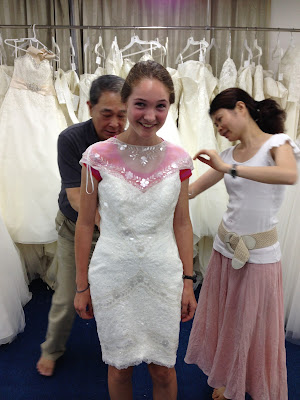BY PERRIN
Kindergartens are rowdy places... this one's rowdier. Kindergartens are noisy places... this one's noisier. Kindergartens are places with toys and colors... this one doesn't have any. What does this one have? It has books, pencils, backpacks, desks, chairs, and a loud teacher in a room of 35 five-year-olds... to whom we had to teach English.
We are in Xizhou, a village about 20 minutes away from Dali, in southwestern Yunnan province, a popular tourist destination with streets full of buyers and sellers. We are here for two weeks so we wanted to do something to help the community. We decided to volunteer at a local kindergarten/preschool right down the road from where we are staying. We didn't know what we were in for.
The first day, as we walked to the school with my mom, Andrew, who helped us set up the teaching, told us that the teacher was "super nice" and would help us for the first day and tell us what to do. I was happy about that and expected to see a room full of toys and kids playing. I was in for a big surprise.
When we got there Andrew introduced the teacher to us and I looked around. All the kids were in their classrooms and I could see that the ages ranged from 3-6, depending on the class. The children were all crammed at desks or wandering around aimlessly. Some were practicing their Chinese characters while others stared at us like we were aliens. Andrew and my mom left and the teacher ushered us into the older kids' classroom (5-6 year olds) and gave us a bucket of plastic fruits and tiny animal figurines. My sister and I stood there in the front of the class speechless and confused. We were supposed to stand there for an hour and make 30 kids say fruit names? The teacher looked at us expectantly as the kids' chatting grew louder, so I did the only thing that made sense. I took the apple out of the bucket, held my hand up and said, "APP-PLE." The class quieted down somewhat and about half of it echoed, "AP-PLE." I said it a few more times and then took out the banana and taught them BA-NA-NA. After about half an hour of that, the kids understandably started to get restless and some started wandering around in and out of the classroom. Two kids at the back of the classroom actually walked out the door and then climbed back in through the window onto a desk! The teacher was in the back picking her wart with a needle and ever ten minutes soured, "AN JING!" which means QUIET! We got through the whole hour, though not very gracefully, and knew that we needed a lesson plan for the next day.
That night, our mom, a Montessori teacher, and Andrew, who had taught English to kids before though in a much easier environment, helped us plan a lesson and Andrew taught with us the next day. We played a few games and only the ones that we attempted to do outside totally failed. All the other kids came out of their classrooms to watch us and there was too much noise and distraction. However, it went much better than the day before.
The rest of the week went reasonably well and so did the next week, but it surprised us how hard it was to find games that would work with that many kids in such a tiny room. We looked at a website that Andrew had used when he taught English to kids in China, but most of them required more space than we had, so we only found about 5 games that would work. Andrew was surprised at how hard the teaching was and what a contrast it was to his prior experience teaching in Hangzhou. There, he had only ten well-behaved kids in a big room.
It was useful to learn what the hardest kind of teaching is like. After this, any other teaching will be simple. I am glad that we did the hardest teaching first so whenever we're in another challenging teaching situation, we can always say, "We've had worse!"














































